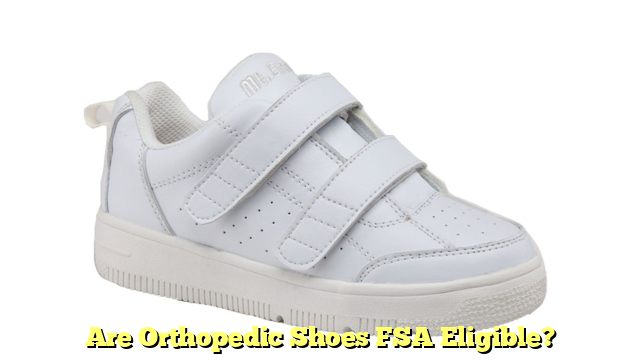Are Orthopedic Shoes FSA Eligible?
If you need a new pair of orthopedic shoes, you can use your FSA. These shoes may be eligible for reimbursement, but you must make sure you have enough money in your account to cover the cost. In addition, your FSA debit card will only be accepted for the amount you have in your account. If you don’t have enough money in your account, you may want to use your credit card or over-the-counter medication to help you afford the new pair.
Pedorthic or Orthotic and Prosthetic (O&P) facilities may fit shoes
Certified pedorthists are trained to provide comprehensive care for patients with pedorthic conditions. This includes assessment, formulation of treatment plans, implementation of the plan, and follow-up. Certified pedorthists work in conjunction with orthotists and podiatrists to provide comprehensive care. They can be found in hospitals, wound care centers, and orthopedic and shoe manufacturing facilities. In addition, they may work in central fab operations and in orthopedic shoe manufacturing facilities.
Professionals in O&P facilities include certified fitters, registered technicians, and assistants. A certified fitter can provide care to patients by fitting orthoses, therapeutic shoes, and soft goods. A registered technician works with an orthotist to design and fabricate orthoses and other devices. However, he or she does not provide direct patient care. A registered assistant assists the O&P practitioner by performing patient management and fabrication.
In addition to providing orthotics, pedorthists can also fit orthopedic shoes. These footwear are custom-molded to fit a patient’s foot. Pedorthics are designed to improve function and mobility. Orthotic shoe devices help relieve pain and restore gait efficiency, and rocker soles compensate for limited joint motion. In addition, extra-deep shoes protect diabetics.
The American Board for Certification in Orthotic and Prosthetic facilities (ABCOP) focuses on administrative issues that affect the profession. AOPA members represent manufacturers and O&P facilities. The organization promotes excellence in patient care, the highest ethical standards, and the integrity of the profession. For more information on certified O&P facilities, visit the AOPA website.
A pedorthic facility fits orthopedic shoes for patients with a variety of medical conditions. These devices may include custom therapeutic shoes, shoe modifications, or partial foot prosthesis for amputations. Additionally, pedorthic facilities may fit orthopedic shoes for patients who have diabetes. If the prescription is obtained from a qualified health care practitioner, the shoes may be covered by Tricare.
Over-the-counter medications
Are orthopedic shoes fSA eligible? If so, you can purchase them and apply the savings. The only requirements are that they treat a medical condition or prevent it. Arch supports and other inserts are a good example. In addition, moisturizers and broad-spectrum sunscreen with SPF 15 protection are eligible. They have a three-year shelf-life. If you have a medical condition and need the inserts, you can apply the money towards the cost of these items.
Some over-the-counter items are covered by HRAs. For example, you can purchase orthopedic shoes with your HRA. However, it is best to ask your health care provider to sign a letter of medical necessity, since OTC items can be bought without a prescription. But, you should also remember that FSAs do not cover prescription drugs. In general, if an orthopedic shoe costs less than $500, you can claim its full value.
To make the most of this tax benefit, you must have a letter of medical necessity from a qualified health care provider. This letter will confirm that your orthotic footwear is necessary for your condition. It is best to seek advice from a pedorthist, certified pedorthist, or other qualified health care professional to ensure that you are receiving the correct size and type.
The Coronavirus Aid, Relief and Economic Security Act added feminine hygiene products to the FSA. You can also use your FSA for period products, such as menstrual cups. However, FSA funds do not cover general tooth-care products. Similarly, the morning-after pill is available without a prescription, so you can use FSA funds to buy it. Nicotine gum and patches, which are popular with smokers, are FSA eligible purchases.
Prescription drugs
The use of orthotic shoes, also called prescription orthotics, can reduce pressure on the foot and increase walking and sports performance. Nearly everyone has suffered from foot pain at some point in their lives. In fact, a poll by the American Podiatric Medical Association showed that over half of the population misses work due to foot pain or injury. This is understandable, as the feet carry a significant amount of weight.
These custom-made shoes are covered by Medicare for those with foot problems related to an uneven volume or length of lower limbs. In addition, certain over-the-counter orthotics are covered as medical supplies. However, these are not suited for long-term use and should be used only when a physician prescribes them. Children should not wear over-the-counter orthotics. If you have diabetes, consult your doctor if you are not covered by Medicare.
The prescription for orthoses contains detailed instructions for production and composition. Although the terminology isn’t widely understood, it outlines specific design features. A qualified doctor can write a prescription for an orthotic shoe based on a patient’s condition. It is possible that a pedorthist who has completed 6th level qualification in a medical school may prescribe the same type of orthoses as an orthotist.
Many people with lower limb problems use orthopedic shoes in order to improve walking. Orthotics are prescription inserts placed in the shoe to correct abnormal walking patterns. They also improve the alignment of the foot when it hits the ground. They are effective in easing foot, leg, and lower back pain. But what about their use for sports? For example, if a person has a severe case of spastic paralysis, he or she may be prescribed molded polypropylene orthotics to improve his or her walking patterns.
Denture stain cleaner
You can buy orthotic shoe inserts that are FSA-eligible if you purchase them for a medical condition or to prevent injury. The most common type of orthopedic shoe insert is an arch support. Sunscreen with SPF 15 or greater protection and a moisturizer with SPF 15 or higher are also eligible for FSA coverage. The good news is that you don’t have to use your FSA benefits until they expire!
In order to get reimbursement for your orthotic footwear, you must first make sure your FSA account is sufficient to cover the cost of the shoe. If you need to use a debit card to pay for the shoes, make sure that the amount is sufficient. You should not spend more than the FSA allows for in a calendar year. To maximize your reimbursement, you should also submit your receipts. Your receipts are your proof of purchase, so make sure you save them.

